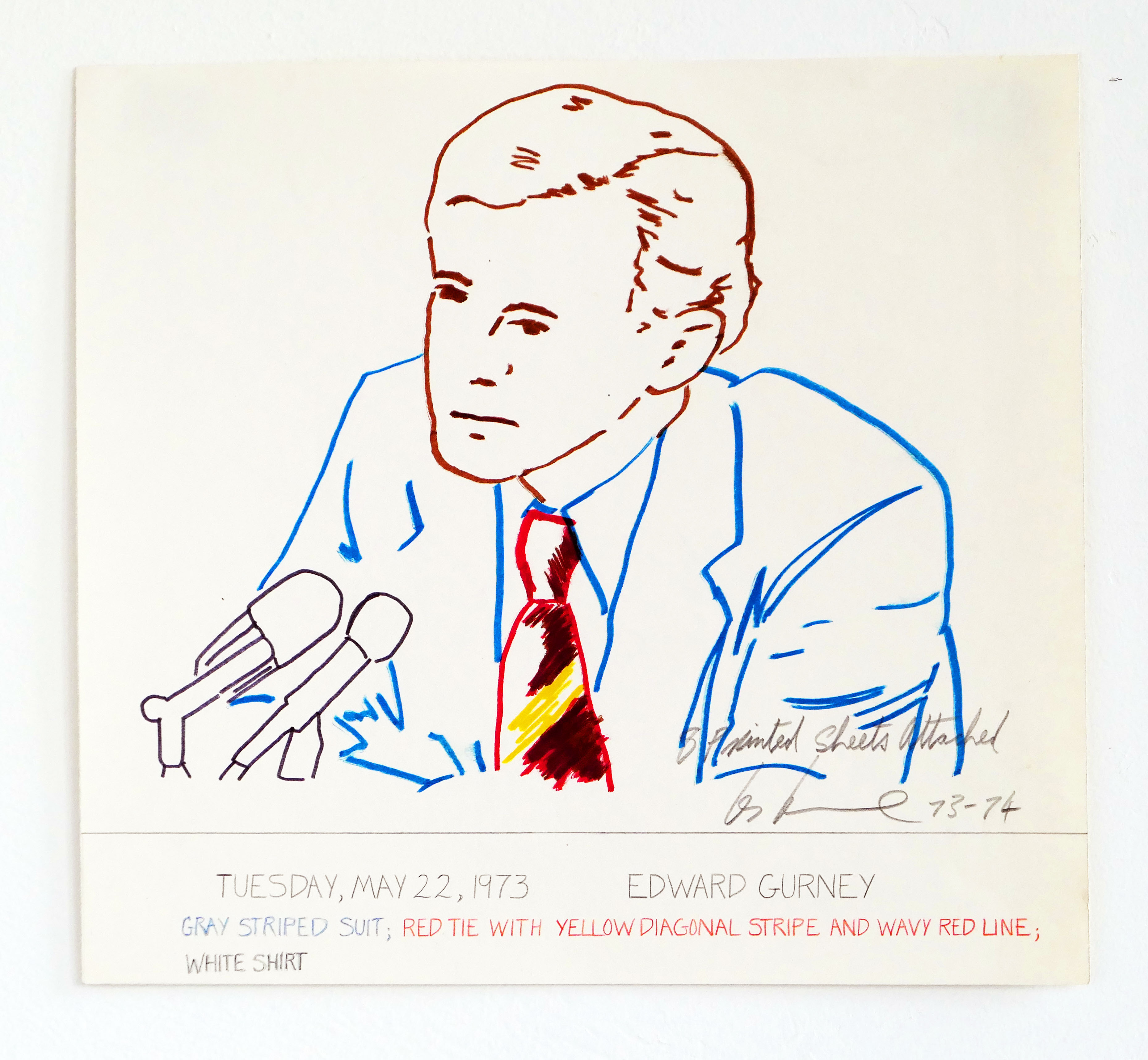Les Levine's Watergate Fashions, A Sound Installation

Blank Forms
Brooklyn, NY 11238
Opening reception May 11, 6–8pm
Gallery hours 11am–6pm, Wednesday–Friday; 12pm–6pm, Saturday
Between May and October of 1973, Les Levine found himself watching the Watergate proceedings each day, the first senate hearing to be publicly broadcast in full. Considering the proceedings to illustrate television’s cybernetic qualities, and to justify the time spent, he endeavored to make a work. Levine, whose interventions into electronic media date back to 1964, was fascinated with the way televisual imagery’s allure supersedes its intended meaning. In his words, like a dogmaless religion or a subliminal command system, the senatorial broadcast was creating an elliptical loop of identification and desire. In step with his burgeoning theories of media and self, he began to mine the hearings for their most overt signal, zeroing in on a bountiful surface: the sartorial tastes of the participants.
Levine’s work is known for its sly evasion of straightforward politics, and Watergate Fashions, 1973, is no different. The artist diligently cataloged the daily attire of every member of and witness to the Senate Watergate Committee, approximately five hundred outfits in total. The project was originally exhibited as a series of photographic slides at New York’s Steffanotty Gallery in spring 1974, accompanied by a recording of the artist reading the list of clothing, and it was displayed later that year as a large wall of sketches. In the piece, Levine presents a parade of starched white shirts and suits of various shades with intermittent flourishes: pinstripes and plaids; eccentric ties and flag lapels; the pearl choker necklace of G. Gordon Liddy’s former secretary, Sally J. Harmony; and the pinky ring of Sam Ervin, senator from North Carolina. In the sonic variation presented at Blank Forms, Levine recites the get-ups in unflappable deadpan over saccharine ballads by Bill “Mr. Ink Spot” Kenny, lead tenor of the namesake easy-listening vocal group. Collectively, the ensembles demonstrate television’s recursive impact on the senators’ appearances, the tyranny of the image, and the high-flown banality of historical drama.
At Blank Forms, Levine reconstructs the project as a room-sized installation of sound and red gel lights that cast a haunting crimson glow on the empty gallery space, evoking the deep recesses of the mind and the shroud of collective memory. In this reduced form, the artist invites spectators to recreate the fashions in their own imaginations, abstracting their meaning and effects into a purely interior process. As Levine predicted about the hearings’ participants: “The way they look will far outlast what they said.”
Organized by Lawrence Kumpf and Tyler Maxin.
Les Levine is widely considered an originator of media art, working across an array of disciplines and forms—among them plastic environs, mass-produced objects, disposable art, magazines, video installations, large-scale public art, and Levine’s Restaurant, 1969, a venue that billed itself as New York’s only establishment for “Irish Jewish Canadian cuisine.” In 1966 he made Slipcover, the first major installation work for the Art Gallery of Ontario, and the following year he won first prize in the Canadian Sculpture Biennale for his work All-Star Cast (A Place). Since 1976, he has produced major media campaigns around the world, including We Are Not Afraid, 1981, in the New York subways; Blame God, a series of billboards mounted across London, Derry, and Dublin in 1985–-86 and presented by the Irish Museum of Modern Art in 1994; and Send Receive in Vienna, 1994, for which he received the Gustav Klimt Prize. Further memorable ventures include his monthly magazine Culture Hero, 1969–70 and the conceptual museum and consultation service the Museum of Mott Art Inc, 1970. Born in Dublin in 1935, Levine studied at the Central School of Arts and Crafts, London, and the New School of Art, Toronto, before establishing himself as a prominent figure in New York conceptual art in the 1960s. A forerunner in media experimentation—his earliest videotapes were produced in 1964 and he developed television installations as early 1968—his work presaged that of a generation of artists working in moving image including Dan Graham and Bruce Nauman. Les Levine’s work is in many international collections. He has taught drawing at Nova Scotia School of Design, Halifax; television production at Wayne Paterson University, New Jersey; communications at New York University, and performance art at Columbia University in New York, where he continues to live and work. Earlier this year, Amsterdam’s Slowscan Records released the LP Game Room—A Tribute to The Great American Loser, which includes a version of Watergate Fashions.
Blank Forms’s gallery space is located on the third floor of 468 Grand Ave in Clinton Hill. There is a step down from the street into the building and two flights of stairs—thirty-five in total, plus a hand rail—up to the gallery. If you require help accessing the space, please contact jade@blankforms.org.